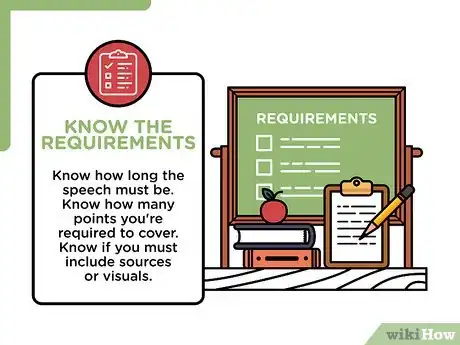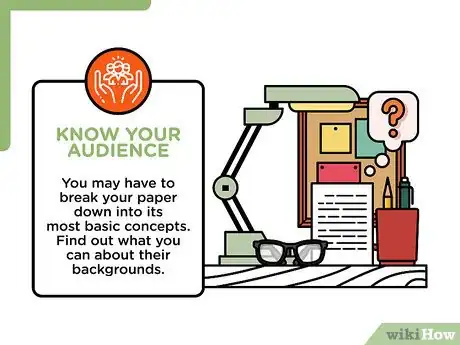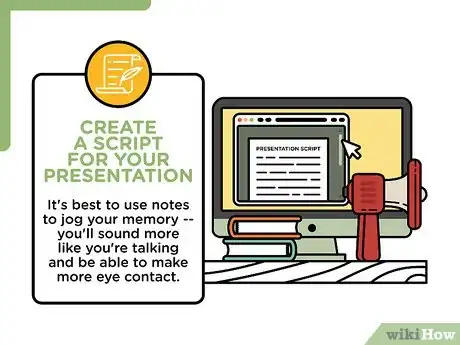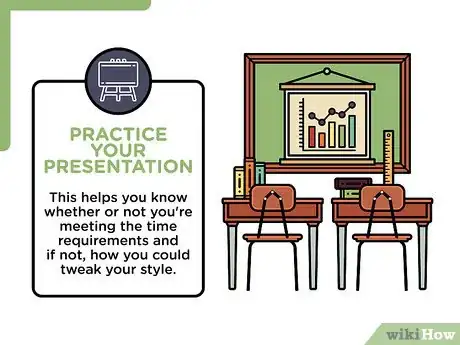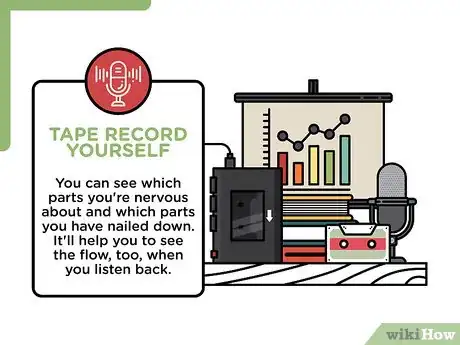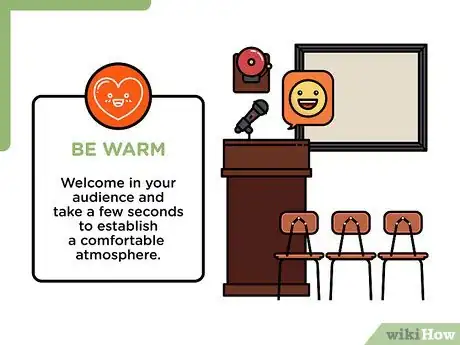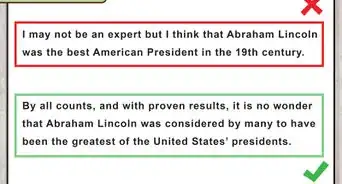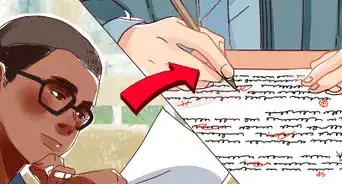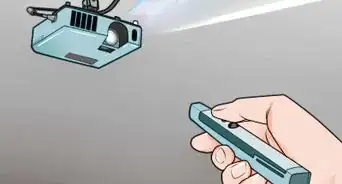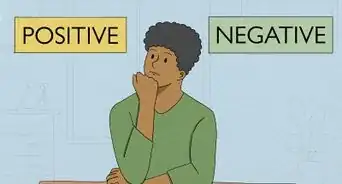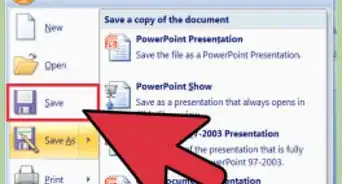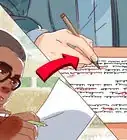wikiHow is a “wiki,” similar to Wikipedia, which means that many of our articles are co-written by multiple authors. To create this article, 17 people, some anonymous, worked to edit and improve it over time.
There are 9 references cited in this article, which can be found at the bottom of the page.
This article has been viewed 331,215 times.
Learn more...
A paper is bad enough, but presentations are even more nerve-wracking. You've got the writing down, but how do you turn it into a dynamic, informative, enjoyable presentation? Why, here's how!
Steps
Guidelines and Audience
-
1Know the requirements. Each presentation for each class is going to be a bit different. Some instructors will be happy with 3 minutes while others will demand you stand there awkwardly for 7.[1] Have all the guidelines clear when you go to write your presentation.
- Know how long the speech must be.
- Know how many points you're required to cover.
- Know if you must include sources or visuals.
-
2Know your audience. If you're giving a presentation to your classmates, you probably have a rough idea of their knowledge on the topic. But for virtually every other circumstance, you may be in the dark. Either way, cater your paper to make zero assumptions.[2]
- If you're presenting to people you know, it'll be easy to know what to break down and what to gloss over. But if you're presenting to unknown stockholders or faculty, for instance, you need to know about them and their knowledge levels, too. You may have to break your paper down into its most basic concepts. Find out what you can about their backgrounds.
Advertisement -
3Know your resources. If you are giving a presentation in a facility you've never visited before, it's best to inquire about what you'll have at your disposal and what you'll need to set up beforehand.[3]
- Does the facility have a computer and projector screen?
- Is there a working WiFi connection?
- Is there a microphone? A podium?
- Is there someone who can assist you in working the equipment before your presentation?
Script and Visuals
-
1Create a script for your presentation. Although you could write everything out, it's best to use notes to jog your memory -- you'll sound more like you're talking and be able to make more eye contact.[4]
- Only have one point per notecard -- that way you won't end up searching the notecard for your information. And don't forget to number the cards in case you get mixed up! And the points on your cards shouldn't match your paper; instead of regurgitating information, discuss why the key points of your paper are important or the different points of view on this topic within the field.
-
2Decide on a limited number of ideas you want your audience to comprehend and remember. To do this, find the most important points in your paper. These are the ones you should be drilling home. The rest of your presentation should be extras not necessarily addressed in your work -- if they've already read the paper, they don't need to be lectured on it. They're there to learn more.[5]
- Make an outline of the highlights to help you prepare your presentation. As you form the outline, you'll see what aspects of your paper pop out the most and what order they would best be relayed in.
- As you go through this outline, remove any jargon if it may not be understood.
- Make an outline of the highlights to help you prepare your presentation. As you form the outline, you'll see what aspects of your paper pop out the most and what order they would best be relayed in.
-
3Design visual aids to make your presentation even better. To help your audience follow along (and for the visual learners), use slides with graphics, charts, and bullet points to make everything a bit more captivating. It can enhance the information in your paper, yes, but it also keeps everyone from wiggling around in their seats.[6]
- If you have any statistics at all, turn them into graphs. The contrasts will seem more stark when put in pictures before your audience -- numbers are sometimes meaningless. Instead of thinking about 25% and 75%, they'll be thinking about the 50% difference they see before them.
- If you won't have access to the proper technology, print visual aids on poster board or foam-core board.
- Presentation software (Powerpoint, etc.) can also double as notecards. Instead of messing with small pieces of paper, you can just click a button to get your next prompt.
- If using presentation software, use words sparingly, but enough to get your point across. Think in phrases (and pictures!), not sentences. Acronyms and abbreviations are okay on the screen, but when you talk, address them fully. And remember to use large fonts -- not everyone's vision is fantastic.[7]
- If you have any statistics at all, turn them into graphs. The contrasts will seem more stark when put in pictures before your audience -- numbers are sometimes meaningless. Instead of thinking about 25% and 75%, they'll be thinking about the 50% difference they see before them.
-
4Think in terms of conversation. Just because this is paper-based does not mean your delivery should be equivalent to what an 8.5 x 11 can do. You have personality and are a human engaging with an audience. Use their humanness to do things you might not otherwise do in a paper.[8]
- It's okay to be a bit repetitive. Emphasizing important ideas will enhance comprehension and recall. When you've gone full circle, cycle back to a previous point to lead your audience to the right conclusion.
- Minimize the unnecessary details (the procedure you had to go through, etc.) when highlighting the main ideas you want to relay. You don't want to overload your audience with fluff, forcing them to miss the important stuff.
- Show enthusiasm! A very boring topic can be made interesting if there is passion behind it.
Practice, Practice, and More Practice
-
1Practice your presentation in front of friends and family members. Don't be shy -- ask for constructive criticism. This helps you know whether or not you're meeting the time requirements and if not, how you could tweak your style. And once you've recited it 20 times before breakfast, your nervous should be at a minimum.[9]
- If you can grab a friend who you think has a similar knowledge level to your audience, all the better. They'll help you see what points are foggier to minds with less expertise on the topic.
-
2Tape record yourself. Alright, so this one is a little much, but if you're really nervous, you may find listening to yourself beneficial. You can see which parts you're nervous about and which parts you have nailed down. It'll help you to see the flow, too, when you listen back.
- It'll also help you with volume. Some people get rather timid when in the spotlight. You may not be aware that you're not loud enough!
-
3Be warm. You are allowed to be a person, not just a machine that relays facts. Welcome in your audience and take a few seconds to establish a comfortable atmosphere.
- Do the same with your conclusion. Thank everyone for their time and open the floor for any questions, if allowed.
Community Q&A
-
QuestionI don't have any confidence in my English speaking. Can you give me any suggestions?
 Community AnswerIt's okay if you are not confident about your English. Write the whole thing that you are going to present and refer it to your friends who are good at English and ask them to correct the mistakes. After doing this, practice the whole presentation for several times until you get confident. Just make sure that you are not reading the whole thing as it is set forth in the paper. Use your own words in between the presentation to ensure the clarity of your presentation. Finally, the only way to get confidence in English speaking is to practice a lot. If you are scared about something, then try to do it again and again, so as to reduce your fear. And don't forget that it's okay to be a litter nervous, it helps you to do it properly.
Community AnswerIt's okay if you are not confident about your English. Write the whole thing that you are going to present and refer it to your friends who are good at English and ask them to correct the mistakes. After doing this, practice the whole presentation for several times until you get confident. Just make sure that you are not reading the whole thing as it is set forth in the paper. Use your own words in between the presentation to ensure the clarity of your presentation. Finally, the only way to get confidence in English speaking is to practice a lot. If you are scared about something, then try to do it again and again, so as to reduce your fear. And don't forget that it's okay to be a litter nervous, it helps you to do it properly. -
QuestionHow do I reduce stage fear?
 Community AnswerPractice in front of the mirror. Present your paper in front of your friends and colleagues.
Community AnswerPractice in front of the mirror. Present your paper in front of your friends and colleagues. -
QuestionHow do I prevent myself from getting nervous about the judges' questions?
 Community AnswerFirst, be yourself and be confident that you know the answers. Then, listen carefully to the question. Then say, "That's a very good question". After that, answer in good and polite way.
Community AnswerFirst, be yourself and be confident that you know the answers. Then, listen carefully to the question. Then say, "That's a very good question". After that, answer in good and polite way.
Warnings
- Answer questions only if it is related to your presentation. Keep these to the end of your talk.⧼thumbs_response⧽
References
- ↑ https://theihs.org/blog/prepare-for-a-paper-presentation-at-an-academic-conference/
- ↑ https://writingcenter.unc.edu/conference-papers/
- ↑ https://www.ncsl.org/legislators-staff/legislative-staff/legislative-staff-coordinating-committee/tips-for-making-effective-powerpoint-presentations.aspx
- ↑ https://www.youtube.com/watch?v=4qZMPW5g-v8
- ↑ https://twp.duke.edu/sites/twp.duke.edu/files/file-attachments/paper-to-talk.original.pdf
- ↑ https://www.ncsl.org/legislators-staff/legislative-staff/legislative-staff-coordinating-committee/tips-for-making-effective-powerpoint-presentations.aspx
- ↑ http://www.cs.swarthmore.edu/~newhall/presentation.html
- ↑ https://www.forbes.com/sites/georgebradt/2014/09/10/big-presentation-dont-do-it-have-a-conversation-instead/#6d56a3f23c4b
- ↑ https://twp.duke.edu/sites/twp.duke.edu/files/file-attachments/paper-to-talk.original.pdf
About This Article
To prepare a paper presentation, create an outline of your content, then write your script on note cards or slides using software like PowerPoint. Be sure to stick to one main point per card or slide! Next, design visual aids like graphics, charts, and bullet points to illustrate your content and help the audience follow along. Then, practice giving your presentation in front of friends and family until you feel ready to do it in class! For tips on creating an outline and organizing your information, read on!
